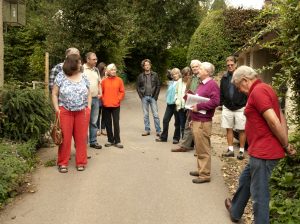The Bourne Conservation Group’s Historical Project had its origins in the group’s scheme to rescue the Old Churchyard and enhance its biodiversity, which started in the Autumn of 2008 (click here). As the Old Churchyard was opened up, memorial stones and unmarked graves were uncovered and we decided to research the history of the site and those who are buried there. Considerable research into national Census records by one of our members, the late Wendy Maddox, and access to burial records assembled by the Farnham branch of the West Surrey Family History Society enabled the Group to piece together the stories of many of the local families. From here, it was a logical step to widen our research to discover more of the history of the Bourne as it changed from a small semi rural, heath-land community to the residential area that it has become today.
One hundred years in The Bourne.
The span of around one hundred years between the laying of the foundations of the original church in 1861 and the final burials on the site, in the 1960s, presented a manageable and interesting period for the first stage of the Group’s Historical Project. Over the hundred years, the population of the Bourne had grown from some 600 parishioners, for whom the original church was required, to about 2,600, for whom the present church of St.Thomas-on-the Bourne was built, starting in 1909. The extension of the railway to Farnham in 1849, the establishment of the Aldershot Garrison in 1855 and widespread access to mains water and a central sewage treatment plant all contributed to significant changes in the character and social structure of The Bourne, changes that were already occurring across the country. By the mid nineteenth century the traditional rural way of life, focused on seasonal activities and traditional skills, with its emphasis on thrift and self sufficiency, was giving way to the money based, consumer economy that we are familiar with today. The upheaval in rural social structures and customs, brought about by new agricultural practices and technological advances, and aggravated by the loss of “cottagers’ ” access to grazing on the common land through enclosure laws, was profound. We drafted a brief article on the nature and effects of these changes which was published in the Farnham and District Museum Society’s Journal for March 2013. This was entitled “The Bourne: Tracing the Development of a Small Community” (click here)
Making a start: Researching the history of the Old Churchyard
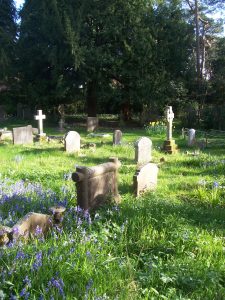
While many of those buried in the church yard had military backgrounds having been based, at some point, at the Aldershot Garrison and having probably spent their retirement in the area, a number were builders and ‘scaffolders’, domestic servants and general labourers who would have been servicing the unremitting spread of new housing. As in every graveyard, there are dignified monuments to the ‘great and the good’, such as the one to The Reverend Thomas Sidebotham, first vicar of the Bourne, or Major General Eric Nares (CBE,MC), awarded the Legion of Merit by U.S President Harry Truman, as well as unmarked graves, such as those of Fred Grover, George Sturt’s gardener, and Fred’s wife, Lucy, which we have marked with extracts from The Bettesworth Book and Lucy Bettesworth, giving a fascinating thumbnail sketch of a labourer and his wife in mid nineteenth century (see the link in the Section on Heritage Open Days)
Information on the 700 plus monuments and graves in the Old Churchyard can be accessed through the following links:
- A map of the burial plots (click here)
- Burial records arranged by name, (click here)
- Burial records arranged by plot number (click here)
Our growing knowledge of the site established that the avenue of (originally) eight lime trees leading up to the north door of the church and the two yew trees at the NE and NW corners of the site were donated by James Knight of Vernon House in Farnham to commemorate the wedding, in 1863, .of the then Prince and Princess of Wales (later King Edward VII and Queen Alexandra). We also discovered that the Revd.Thomas Sidebotham’s ‘ sister, Mary Ann Sidebotham, through the sale of her remarkably successful Children’s Hymnbook, had raised sufficient funds to have the lychgate built in 1888. For a brief history of the Children’s Hymnbook click here.
In 2014 (the centenary of the outbreak of the First World War) there was particular interest in those who died during the war and are commemorated in the Old Churchyard – Captain Archibald F Raffin MC [Devonshire Rgt.], Captain John O Slaught [Canadian Infantry] who married the daughter of Farnham Superintendent of Police, was awarded the MC but was killed in France on the day before the 1918 Armistace, Lieutenants Morris and Edward Birkbeck [Indian Army] and Seaman William H Othen RN. There is one registered war grave on site, that of Private Arthur Culver of the Queen’s Royal West Surrey Regiment who was wounded in the Battle of the Somme, brought back to hospital in London but died of his injuries. On his grave is remembered his brother William who was killed later in WWI but is buried where he fell in France.
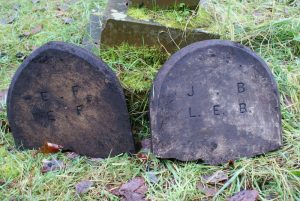
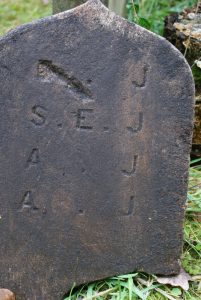
While working in the Old Churchyard some small inscribed gravestones and pieces of kerb were discovered, as shown in the photographs. From the available records it was possible to identify the initials on the monument shown opposite as belonging to the four children of George and Susannah Jeffrey, the eldest of whom, Emily, died aged 21 yrs, while the other three died in infancy, Susan Ellen at under 2 years, Albert surviving for only 21 days and Annie for only 3 months. The Group later decided to investigate the very high levels of infant mortality, putting on a tour entitled “From Wells to Mains”- the story of Farnham’s water supplies. This was arranged in partnership with staff from South East Water and first run as part of the Farnham Society’s 2016 Heritage Open Days programme. (click here)
The second picture shows three “footstones”, commonly used to mark the foot of a grave. They may have been removed years ago to simplify grass cutting in OCY. Our aim will be to replace them on the family graves.
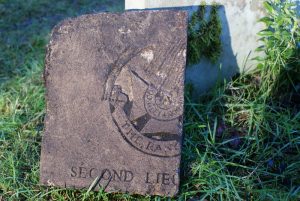
The story of the above fragment, for which, there is no name or date, is difficult to work out. It appears that it was prepared for a Second Lieutenant. The badge has been identified as that of the 12th (County of London) Battalion of the London Regiment (The Rangers). This was a most interesting unit that took part in the First World War.
Concluding the first stage: Open Day June 2010
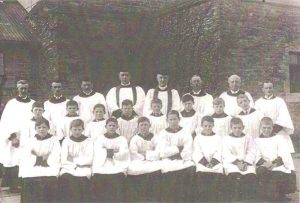
By the Summer of 2010 we felt that we had gathered sufficient detail of the history of the Old Churchyard to invite members of the public to visit the site. On Sunday 27th June 2010, coinciding with the national “Cherish Your Churchyard” project, the Group offered a series of hourly tours, covering the wildlife, ecology and local history of the Old Churchyard and the work undertaken by the Group to open up what was, at the time a very overgrown site, to create a place for quiet remembrance and a habitat for wildlife. A number of interesting graves were identified and Wendy Maddox was on hand to provide information on the families she had researched
A gentleman in his nineties, Fred Collins, brought a copy of a photograph of himself in the Church Choir in the 1920s and, at the grave of Flight Lt. Richard Waghorn DFC, a lady told us she had witnessed the 1929 International Schneider Trophy race won by Waghorn, one of the British team flying a Supermarine S6 aircraft designed by R.J. Mitchell as a forerunner to the Spitfire. More detail about some of the graves is given in the section on Heritage Open Days (click here).
Also of interest, perhaps, are the graves of:
[1] Colonel Montague Wilbraham Taylor, a flamboyant individual, who established a Temperance Hall, on Gravel Hill (the Frensham Road) which is now the local Scout Hut.
[2] Patrick Lewis Paget, who inherited Brightwell House from his father-in-law the Rev. Richard Garth and one of whose daughters was a godchild of Florence Nightingale.
[3] Lt. William Russell Steele RN who was accidentally given an overdose of strychnine by Surgeon Lt Veitch while serving on the British V Class destroyer HMS Vancouver.
[4] Major General Eric Paytherus Nares CB, CBE MC (with Bar) who served as a distinguished soldier in both world wars and was awarded the Legion of Merit by President Harry Truman. Click here for further information about Eric Nares and his family – “A forgotten Family”.
Moving beyond the Old Churchyard
For the reasons already mentioned, our recent research has focused on how and why the Bourne became what it is today. Central to this are the writings of George Sturt.
George Sturt – 1863 -1927
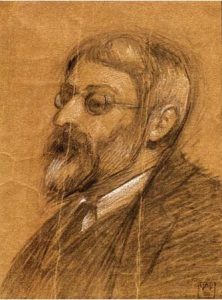
Another close friend of Sturt’s was William Herbert Allen who was Head of Farnham Art School for 40 years and later responsible for the teaching of Art in all Farnham schools. He married Adelaide Maria Sothern at the old church in July 1905 and the couple had Strangers’ Corner, on the Tilford Road, designed for them by local architect, Harold Falkner, who had been a pupil of Allen’sFor more details, including images of some of Allen’s paintings (click here)
Some idea of the nature of the Bourne in the mid nineteenth century and scale of the changes is given by Sturt (a little dramatically, perhaps), in Change in the Village.
“I doubt if the cottages are more than a century old; even if any of them have a greater antiquity, still it is not as the last relics of an earlier village that they are to be regarded. On the contrary, they indicate the beginnings of the present village. Before them, their place was unoccupied, and they do but commemorate the first of that series of changes by which the valley has been turned from a desolate wrinkle of heaths into the anomalous suburb it has become today.”
and, looking over the valley at dusk:
Where but a few years ago the quiet depths of darkness were but emphasised by a few glimmering cottages, there is now a more brilliant sparkling of lit up villa windows”
Developing the Historical Project.
Keeping in touch with the local community is very much part of the historical project, both as a way of acquiring fresh information and building up local knowledge of the rich history and ecology of The Bourne. The Group believes that an effective way of maintaining contact with the local community is through active participation in the annual Heritage Open Days programme, organised by the Farnham Society and through other ventures, such as the Farnham Walking Festival, introduced in 2017 for which the Group organised three walks. The Group has also offered talks to local groups on the history, ecology and wildlife of the area, as well providing Members and Friends with a quarterly Newsletter.
The Group’s first Heritage Open Day was in 2013 with a guided tour of the Old Churchyard and the Old Church Lane area of the Bourne, which is closely associated with George Sturt. Over the following two years we extended the same tour to include additional features such as a visit to the site where the young William Cobbett allegedly played with his two brothers.
In 2017 the Committee decided to do something slightly different and, as mentioned above, joined up with staff from SE Water to provide a guided tour explaining the effects that a clean, accessible supply of piped water and a central sewage plant had on the character of the Bourne and its inhabitants, and on the development of the Bourne as a residential area.
For more information about our Heritage Open Days tours (click here)
